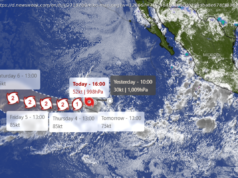On Friday the US President Donald Trump approved a disaster declaration for Hawaii amid heavy damage and the state deals with damage from a volcan
HAWAII, U. S. — On Friday, the U. S. President Donald Trump approved a disaster declaration for Hawaii amid heavy damage and the state deals with damage from a volcanic eruption on its largest island.
According to a statement released by the White House, federal funding had been approved for local recovery efforts in the area affected by the Kilauea volcanic eruption and earthquakes that began early last month.
The White House added in its statement, «Additional designations may be made at a later date if requested by the state and warranted by the results of further damage assessments.”
According to the announcement, Brock Long, Federal Emergency Management Agency (FEMA) head has reportedly named deputy Federal Coordinating Officer Willie Nunn as FEMA’s top official for the state’s relief work.
Hawaii Gov. David Ige (D) had earlier signed a request for a presidential disaster declaration, stating in a press release that a larger-scale evacuation may be necessary as the eruption develops.
Ige said, “As more fissures open and toxic gas exposure increases, the potential of a larger scale evacuation increases. A mass evacuation of the lower Puna District would be beyond current county and state capabilities, and would quickly overwhelm our collective resources. Federal assistance would be necessary to enable us to successfully conduct such large-scale operations.”
The White House added that Federal funding is available to state, eligible local governments and certain private nonprofit organizations on a cost-sharing basis.
The molten lava spewing endlessly for days has put the future of hundreds of people in Hawaii’s Big Island uncertain.
Local reports stated that the Kilauea volcano erupted more than a week ago and has destroyed at least 36 structures so far including 27 homes.
On Friday, the threat of violent explosions prompted authorities to close the Hawaii Volcanoes National Park until further notice.
Meanwhile, officials have stated that the volcanic vents on the ground that released slow-moving lava and toxic gas into island communities are still a hazard.
The U. S. Geological Survet’s Hawaiian Volcano Observatory has stated that no lava was reported from any of the 15 vents but «additional outbreaks of lava are likely.”
Meanwhile, local reports noted that volunteers are assisting about 300 evacuees who have been sleeping at emergency shelters, adding that lawmakers are concerned it could take weeks or even months before they can return home.
Further, authorities have reportedly also allowed the nearly 2,000 evacuees to go inside their homes to pick up their belongings, with the warning that they could have to rush out almost immediately.
With the health of residents and emergency crews in danger, and hazardous fumes releasing continuously, the governor’s office estimated in a statement that the cost to protect residents over the next 30 days is expected to exceed $2.9 million.
According to the University of Hawaii at Hilo, there are high levels of sulfur dioxide, which can cause headaches and irritation to the lungs and eyes if it’s inhaled at higher concentrations.
Experts also added that erupting volcanoes spew the hazardous sulfur dioxide gas and if conditions are right, that gas and other pollutants can settle with moisture and dust to create a haze called volcanic smog, or «vog,» with tiny sulfuric acid droplets.
The U. S. G. S. has stated that high levels of acidic particles in vog «can induce asthma attacks, especially in adolescents, and can also impede the ability of the upper respiratory tract to remove other potentially harmful particles.”






